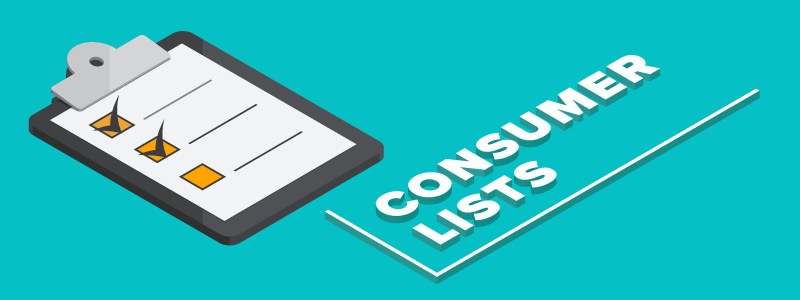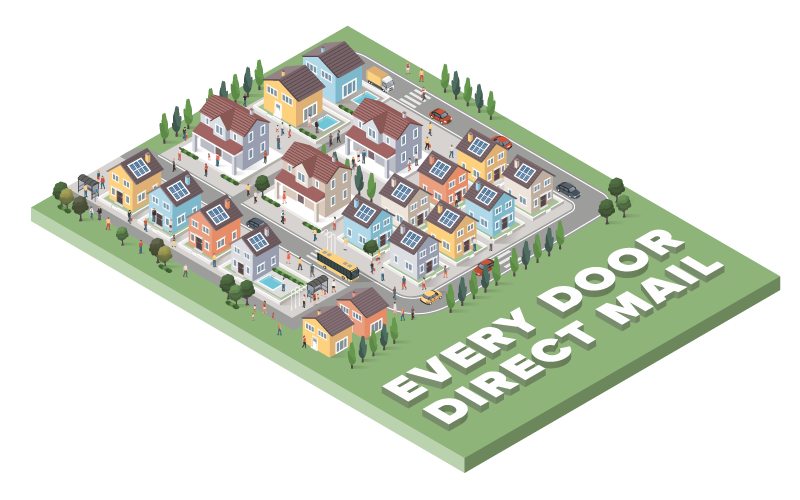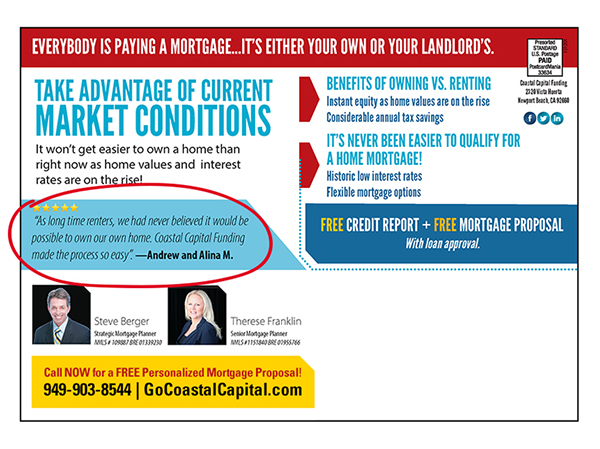Direct Mail Marketing:
The Definitive Advertising Guide (2025)
This is the ultimate guide to using direct mail to blow up your business in 2025. This is not just another "how to design your postcard" post...
Instead, you're going to learn time-tested direct mail marketing strategies that we've perfected over 20 years in helping 124,393 clients grow their small businesses across 68 different industries.
Get ready to see results from campaigns which have gotten businesses ROIs (returns on investment) of upwards of 24,000% — yup, you read right. 24,000%.
So here we go — with this knowledge you’ll have no choice but to hit it BIG in 2025.

Contents
WHO receives your direct mail postcards is equally as important as what is on them.
So what is a mailing list? It’s simply a collection of addresses to whom you mail your direct mail advertising.
The purpose of direct mail lists are to target a large number of prospects who share a trait that qualifies them for your marketing offer.
The ability to target VERY specific groups is the most powerful aspect of direct mail lists.
Depending on the type of mailing list (which I explain below), you can target by several demographics like:
- Age
- Gender
- Income level
- Zip code
- Neighborhood
- And more!
There are even mailing lists that target people by interests, such as readers of a particular magazine or people who have purchased from a specific store.
If you are targeting businesses you can target them by industry, annual revenue, employee size and more.
Different Types of Mailing Lists

1. Consumer Direct Mail Lists
A consumer mailing list contains home addresses and/or email addresses of consumers — People who buy products either from brick and mortar retailers or online. These lists are in turn used to sell products and services directly to individuals and families.
These lists can break prospects down by:
- Age
- Income
- Gender
- Zip code
- Occupation
- Whether they rent or own their home
- Home value
- New homeowners
- And other variables.
Some direct mail house list vendors will include these options (they call them "selects") in their price — others will add on a penny or 2 per record for this data.
Here are some popular consumer mailing lists:
- New homeowner mailing lists
- New resident mailing lists
- New parent mailing lists
- Veterans mailing lists

2. Subscriber Direct Mail Lists
Subscriber lists target individuals who have subscribed to a particular product or service. Magazine publishers normally rent out their subscriber list, oftentimes including a one-time usage clause in their contract (which is something you want to avoid as repetition is key with direct mail).

3. Affiliate Direct Mail Lists
An affiliate mailing list is a list compiled by a company you are in partnership with.
For example, if a local gym has a marketing partnership with a local smoothie shop, they may choose to share their mailing lists with one another, so they both increase the scope of their target market.

4. Business-to-Business (B2B) Direct Mail Lists
B2B lists are most often complied by SIC code (Standard Industrial Classification) — SIC being the government’s codified way of identifying which industry the business operates within. The database is obviously enormous, but there is a way to narrow it down and find the right types of companies to promote to. To search for specific business mailing lists, go to www.census.gov/epcd/www/sic.html and find out their SIC codes for those businesses.

5. Opt-In Direct Mail Lists
An "opt-in list" is a list that someone puts themselves on voluntarily. They may sign up for a newsletter within a certain industry and answer "yes" to wanting to receive offers or information from affiliates of that company. An affiliate would be any company they sold their list to. It was the business transaction that affiliated them. Like any list, an opt-in list can be a valuable source of information if used correctly.
Just remember that opting in doesn’t mean the person is itching to hear from you necessarily. Best to approach them as a cool to moderately warm prospect.
So... is there a mailing list for my industry?
Whatever your industry – YES.
Because targeting can be so specific with mailing lists, virtually every industry and target audience is at your fingertips. See if your industry is on this list of ones we’ve already serviced over the past 20 years.
What in Sam Hill is a mailing list compiler?
A mailing list compiler is a person or company that puts direct mail marketing lists together. There are really only a few companies that handle mailing list compiling on a large scale. Even if you buy through a vendor (see below), you’re probably getting data from one of these massive compilers.
Some of them are:
Sure, you can purchase direct mail lists directly from them, but most savvy business owners get much better pricing by going through a list broker, like PostcardMania, who has negotiated lower pricing for small businesses due to combining many small orders and purchasing in bulk.
Plus, most large list compilers also don’t offer a direct mail marketing strategy consultation with advice on which list — or type of list — is best for your small business and direct marketing campaign.
What’s a mailing list vendor?
A mailing list vendor (or broker) is a middleman between you and the big mailing list data compilers I listed above. A vendor/broker helps you understand exactly what you need for your direct mail campaign and work to obtain it for you.
Since acquiring a mailing list is often a confusing process, it’s easier to have the help of a go-between, aka: a direct mail list vendor or broker — especially if you can get some free direct mail campaign ideas to use.
Want to see how many people you can mail to?
Get a FREE mailing list count here!
How to purchase a mailing list:
Good news:
The buying process is straightforward enough to get your direct mail list. Simply contact a mailing list vendor you trust to begin the process (PostcardMania representatives can be reached at 1-800-628-1804).
The representative should walk you through the process of correctly defining your direct mail campaign’s target market, and then provide you with a potential record count for a list of that kind. You may need to widen or narrow your targeting criteria to arrive at a usable number of address records for your direct marketing campaign to generate you enough leads.
When the vendor acquires the list, they can provide the data to you in a number of ways:
- Microsoft Word
- Microsoft Excel
Or they can potentially provide you with files that will open in standard email clients like:
- Gmail
- Yahoo
- Zoho
- Outlook
But in case you’re thinking...
What if I can’t afford a mailing list?
Know this:
The FIRST thing to keep in mind is that a really good direct mail list MORE than pays for itself in terms of return on investment (ROI). So it’s worth the upfront cost if you have it. But if you don’t have any capital to work with, there are ways to create your own mailing list for your direct mail marketing campaign. It just takes time.
First, get a place to keep and organize your mailing list contacts. This could be as simple as an excel spreadsheet (Excel and Word have list templates that can help you with this) or the contact management solution built into your email client (Gmail, Yahoo, Zoho, etc.), though there are more specific Customer Relationship Management (CRM) solutions that scale better.
Next, create a sign up form on your website to capture direct mail list leads. If you have a Wordpress site, there are numerous Wordpress widgets that can do this. There are also apps for Facebook that let you create contact forms on your page, as well as third party form builders like MailChimp that allow you to collect all your data in one place.
Once you’re all setup, offer customers something of value in exchange for their contact info. This could be a report or a special discount, etc. Additionally, put a sign-up sheet in your actual store for those who browse in-person. Overtime, your direct mail list will grow, and you’ll have an excellent list to advertise by mail to!
What’s “cleaning” a mailing list and do I need a broom
It’s always smart to go through your direct mail lists periodically to remove stale addresses and records you know are dead-end leads. If your list is smaller, you may be able to do this as yourself, but we highly recommend running ALL direct mail lists through the National Change of Address (NCOA) database on a quarterly basis. This ensures all your records are up-to-date, and most importantly:
It saves you money on wasted postage by not mailing to addresses that aren’t good.
At PostcardMania we’ll make sure your direct mail lists are cleaned and mail-able before any postcards ever get mailed to them.
Mailing list cost:
Cost does depend on the list, but for general reference, the basic pricing for consumer list sales is $0.04 per record for one-time use, and $0.08 per record for one year of unlimited use. We HIGHLY recommend the latter, because one-off mailings usually won’t generate you enough leads to justify your overall direct mail cost. Repetition is your friend!
And you’ll learn why repetition creates successful direct mail campaigns in this guide.
A picture may be worth 1,000 words -
But an effective postcard design could be worth 1,000+ prospects.
The design of your direct mail postcards is almost as important in eliciting a response as getting a good mailing list - it runs a very close second.
Much as in deciding on a direct mail list, there are definite rules you should follow when designing your direct mail postcards.
Theoretically, you could slap a design on some postcards, get them printed, and mail them out to your mailing list and see what happens.
However, there's more to direct mail marketing than the bare minimum, and eventually low quality will affect your direct mail campaign, the results you get, and not to mention - Your overall company image and reputation.
I take it that you want to know how you can utilize direct mail services to really grow your company. And that requires more than the bare minimum.
After all, you don't want your direct mail postcards to end up in the trash with the rest of the unread mail.
But inarguably the first thing your postcard recipients notice in direct to consumer advertising is the VISUAL, aka: Your design.
Now your design isn't just the colors and text - it also includes your logo, images, and the layout of the design elements.
I found that the creative direct mail elements can either make or break your direct mail campaign's success, so that's why I give you the 10 critical design tips your direct mail postcards MUST have in order to maximize your leads and return on investment (ROI):
1. A clear, BOLD headline that calls out to your prospects
On the postcard there should be one central message. The best way to achieve that is with a bold, clear headline that isn't cluttered up with other text and that grabs attention FAST. The headline should ideally allow the recipient to immediately know what you're selling.
Here the headline clearly spells out dentistry with SMILE printed large:

2. An image that supports your marketing message and business
The graphic should be easy to understand and add to the message the headline is conveying. For instance, if you are trying to get people to list their home, you would want to show a home with a "SOLD" sign clearly visible out front. That graphic reinforces the message more than a plain picture of a home.
And in this case, we're looking at a family dentistry's postcard, so the image of a mother and her children - all brushing their teeth - quickly communicates that this is a family dentistry.

See how this postcard doesn't use a relevant image:

Avoid being clever with your direct mail marketing, and stick to being clear with your message instead - That way your prospects don't have to try and figure out what your postcard means, and you'll actually keep their attention on your marketing message.
3. Color that POPS out of the mail stack
Use contrasting colors on your postcard to make the elements POP out at your prospect from the mail stack. You can make the headline and other text stick out by using a color that stands out from the background color. When you look at the card, ask yourself, "What do I see first?" If it isn't the headline, you might want to tweak the colors.
This postcard uses blue - a color that's associated with medical fields, cleanliness, and even responsibility - to pop out of the mail stack.

See how this postcard's colors look bland and boring:

Not likely to grab your busy prospects' attention - especially considering they're being marketed to every day constantly. You want to make sure your postcard LEAPS out of the mail stack, so if this means using different, even clashing colors on certain (important) elements - DO IT! Your postcard is a marketing piece meant to pull in tons of interested leads. It's not a painting at the Louvre.

See? That bright pink special offer really pops out against the green landscape-themed background - love it! Here's another one:

That pink area clearly makes you LOOK right at this dentist's contact number.
4. Subheads that lead into text for easy readability
If you have a chunk of text - large or small - with no lead-in, there's nothing easy to read that'll entice people to read more of your marketing copy. A subhead will give prospects a place to start reading.
Remember: Your prospects are B-U-S-Y people juggling their lives, so make it easy for them to read and understand your postcard, and they will...


5. Benefits, benefits, benefits!
One of the biggest errors people make in direct advertising is stating features rather than benefits.
For example, never assume recipients know what benefit can be derived from a lower interest rate on their mortgage. Instead, let them know their monthly payments will go down.
This dentist listed a whole bunch of reasons why to choose them, see:

Plus, bullet-pointed copy makes people look because:
- It's easy to read
- It's short
- And it's scannable.
Moving on...
6. An illustrious special offer that gets the phone ringing
A special offer gives your direct mail postcard recipients a good reason to contact you and try out your business. Your special offer needs to be enticing enough to get leads calling - because, after all, that's point of your direct mail campaign!
Your special offer should represent a specific reason to call right NOW, such as "Limited supply" or "Interest rates are climbing," or "Save $50 before the end of the month."
On this postcard, there are 2 special offers, and they're shown on the front and back.


Tip:
More than 1 special offer shown can work for dentists (and other businesses too) because it's sometimes hard to know which dental service or issue prospects need to handle, so more than one - framed as coupons - gives prospects extra reason to contact you because they know no matter what!
7. Your company name and logo
Although this needs to be on the mailer, it shouldn't overshadow the offer nor be hard to see. Customers care most about what you can do for them - not who you are or how great you say you are.
This dentist's logo is basically his name:

If you want a logo that brands your business and makes you look super professional and legit, our logo design services give you multiple options to choose from.
8. Call to action that tells prospects what to DO
Don't leave it up to luck -
Tell prospects exactly what you want them to do. "Call today for more information" or "See us online" are two of the most common desired actions.

9. Include your contact information
Provide your name, phone number, and web address somewhere on your postcard that's easy to locate - ideally, both on the front and back of your design.
Whatever you ask prospects to do, give them the means to do it - right away.


See how the phone number is on both the front and back here? That's because it's via the phone number that prospects can take advantage of one of those 2 special offers!
10. And your return address
A return address ensures you'll get any returned mail from the post office, and it communicates that you're an established professional. People feel better knowing the company they're dealing with has an actual location.

If you don't have a physical location, don't put your home address nor a P.O box address. Nothing says "not a real business" quite like a P.O. Box...
Instead I recommend you get a mail box at a UPS Store, then you can use their store location as your address, and for your box's number, just put "Suite #" instead.
Want a downloadable version of these 10 design elements?
Get one here and print it out so you have it for handy reference later when you go to order your direct mail postcards!
Remember this:
When a prospect receives your direct mail piece, there's a 95% chance they'll head straight to your website to learn more about you. So make sure your website is setup to catch the leads that come there - otherwise, it's like throwing marketing money away.
Direct mail marketing costs can be broken up 5 ways:
- Printing
- Design
- Mailing list
- Addressing
- And postage.
When you get a quote from a direct mail marketing company vs. say, an online printer, how do you know which price is the better price?
In other words —
Will the LOWEST price necessarily give you the best (lead-generating) direct mail campaign for your business?
Maybe. Maybe not.
Here’s what you need to look at:

Printing
Ask what type of paper your postcards will get printed on. The industry standard for professional postcards is 14-point card stock, which is a nice thick card stock that withstands traveling in the mail. Make sure you’re getting this, otherwise, you may find out too late that your direct mail postcards got printed on flimsy paper that makes your direct mail advertising look dull, cheap, and unprofessional.
Which brings me to...
Gloss. Will your direct mail postcards get finished with a gloss? Better ask! That glossy coat makes your message literally shine and look more professional than a flat matted look.
Basically, if a printing cost looks WAY too cheap, find out why. Just because you’re getting a good deal doesn’t mean you’re getting scammed, it’s best to ask than find out too late you paid for a sub-par project from some direct mail printer.

Design
Not every direct mail company has on-site graphic designers who they train to perfection. Some may outsource this task or use someone who’s really not a skilled graphic designer...
Which could put your entire business’s marketing and reputation at risk.
Plus:
When advertising direct mail style, you need your direct mail postcards to both look awesome and quickly communicate your marketing message with your special offer.
Remember that your direct mail marketing strategy isn’t just an art piece that gets mailed out — It needs to generate clicks, calls, leads, and SALES.
That’s why we design all of our postcards considering what’s already worked for our most successful direct mail campaigns.
And that’s why you need to ensure your postcard will get designed to generate response. A cheaper price may not mean a quality design.
And one more thing on design pricing:
Take a look at how many revisions you get for the design fee you pay.
Chances are, you’ll want to revise your postcard at least 1 time, so make sure you know how much revisions cost (if anything).
A direct mail marketing company can charge you:
- Per revision (yikes)
- Per hour (who knows how many hours?!)
- Or you’ll get charge one flat fee (whew!)
At PostcardMania, we charge just $199 for the design, marketing copy, and unlimited revisions.

Mailing List
I already went over how your mailing list is one of the most important parts of your entire direct mail marketing campaign, so it’s not something you want to cut cost corners on.
When you’re looking at direct mail advertising costs, and let’s say you need to purchase a direct mail list, be weary of the least expensive list option.
Here are some questions to ask:
- How many times can you use this mailing list
- How (and from where) was it compiled
- Were the invalid/bad addresses “cleaned” from the list
- When was it last updated
Note:
You can provide your own mailing list for your direct mail campaign, such as:
- A list of your current customers
- A list of past customers (who haven’t bought in a while)
- Or maybe your own list of prospects you’ve collected.
Whether you buy a mailing list or you provide your own, you’ll need to consider this next cost for your direct mail postcards to actually hit mail boxes.

Addressing
When you order direct mailers, there’s usually a fee for the actual addressing of your postcards.
Make sure you ask what that is so it’s not tacked on at the end as a surprise... or somehow you’re expected to do it (and you didn’t know it!). Addressing 5,000 snail mail postcards by hand isn’t exactly a fun Sunday night...
Here at PostcardMania we only charge $0.05 per piece for addressing (and presorting) your direct mailers. 
Postage
Postage is the most expensive element of your direct mail marketing costs, believe it or not.
However, you can qualify for some generous postage discounts when you buy your postcards in bulk. When you order postcards from the best direct mail marketing companies that have been in business a long time, you may get even lower postage rates since, over the years and mailing millions of postcards, they’ve negotiated special rates with the post office.
Generally, your 4.25”x 6”postcards will get you the lowest price (because they’re the smallest).
Again, there are other sizes with other prices to consider for your direct mail marketing strategy...
That’s why it’s recommended to order your direct mail campaign from a marketing company —
Not just from direct mail printers you search for online.
A marketing company — with proven results — will (and should!) show you the different types of direct mail advertising campaigns that have gotten leads and sales with corresponding postage prices.
Get a FREE sample pack of direct mail postcards mailed directly to you now.
Interested in pricing for the U.S. Postal System’s Every Door Direct Mail (EDDM)? I talk about that next...
When you want to send out direct mailers, you may be looking at either doing it yourself or going with a direct mail company.
In other words:
How do you get the BEST price?
Believe it or not, postage is the lion’s share of your direct mail advertising costs — not the direct mail piece design or even the direct mail services.
There are a few different options for postage (aka: saving $), and it depends on these:
- Whether you’re mailing to a targeted mailing list
- Or if you’re mailing to people in a certain geographic area.
If you’re mailing to a targeted mailing list (meaning, people who share a common trait), you want to do regular direct mail advertising with a mail house...unless you want to design, print, presort, and mail your all your direct mail marketing yourself.
BUT:
If you want to mail to everyone in a certain zip code or neighborhood, you can opt for Every Door Direct Mail (EDDM) — a program the U.S. Postal Service offers which gives postage discounts to people wanting to send business mail to certain zip codes.
I’ll explain how both options work in terms of pricing...

If you address and mail all of your postcards yourself, you pay $0.35 per piece in postage (or $0.55 if you mail larger postcards). Basically — zero discount and LOTS of elbow grease.
If a direct mail company — i.e. PostcardMania — addresses and mails your postcards for you, the postage rate for 4.25" x 6" postcards (a standard size) is between $0.265 - $0.294.
We charge $0.05 per piece for presorting and addressing, which saves you big money (and time) over organizing and mailing your direct mail campaign yourself.
Plus:
When you go with a mail house — vs. doing it yourself — you may qualify for an even deeper bulk postage discount. For example, since PostcardMania is a mail house with a long withstanding relationship with the U.S. Post Office, we’re eligible for all kinds of bulk mail discounts. We actually mail so much that we have an in-house USPS employee at our mailing facility.
That means if and when we handle the mailing for you, we can save you between $0.06 and $0.08 per piece on your total postage cost. That really adds up fast if you’re mailing thousands of direct mail pieces.
And:
You don’t have to do the work, and you’re actually SAVING money while you don’t do it.

Now, if your prospects are all in the same area, you can use Every Door Direct Mail (EDDM).
Say you’re a restaurant, for example, and you want to get the word out about your grand opening. You can mail direct mail postcards to everyone in the 1 or 3 zip codes surrounding your location, like you’re blanketing the area with your direct mail marketing!
EDDM doesn’t work if you want to mail to a target mailing list (from Chapter 2). EDDM only works targeting geographic areas (zip codes).
Think of EDDM like this:
- You decide where you want to mail your postcards
- You design your postcard
- You get it printed following the post office’s guide
- You bundle your postcards
- They go in your postman’s truck to get dropped off along his/her route.
The benefit?
The postage savings!
But there’s a caveat to this price break:
You HAVE to follow the U.S. Post Office’s directions exactly with EDDM specifications — there’s NO wiggle room for mistakes. So to qualify for the postage savings with EDDM, you’ll have to take the time to learn how the program works to ensure your direct mail postcards get printed at the right size and wrapped into bundles 100% correct, otherwise you risk the post office denying your direct mail campaign shipment altogether.
People organize their own EDDM direct marketing campaigns all the time in order to save a little money, and if you have a lot of extra time, doing EDDM solo may be an option for your business if you need to market locally.
Or, if you want you can check out PostcardMania’s EDDM services which will still get you that killer postage discount AND save you tons of time.
We have an entire gallery of direct mail campaign examples, organized by industry for you to see...
But if you want to see some seriously creative direct mail ideas, check these out:
1. Tailor each postcard for its specific recipient
You know when you’re walking in a crowd, and you hear someone call your name?
You pay attention because you think they’re talking to you!
Personalized postcards work the same way.
Using a special printing process — that we paid millions to acquire — called variable data printing technology, you can customize every postcard in your mailing for its intended recipient.
That means:
Not only can you include your prospect’s name in the design of the card (not just in the address field), but you can change elements of your postcard to reflect that person’s demographics or interests!
See below. “Samantha” will be replaced by every name on your list automatically!

2. Give your card a vertical orientation
Humor me for a second:
Think about how you sift through your day’s mail. Are you picturing it?
You’re holding all of the items the same way — horizontally — right?
When you come across something that’s designed vertically, it requires a little extra attention, doesn’t it?
At the very least, you have to turn it on its side so you can read enough to see what it is!
And if it’s offering you something you want or need, you keep reading!
Here’s an example of a home security campaign featuring a vertical orientation:

3. Include a scratch-off area in your design
Everybody likes to play along, right?
Turning your postcard into an interactive game is a great way not only to get people’s attention, but to get them to set aside some time specifically to interact with your message.
And do you know what people like more than playing along? WINNING.
Putting a scratch-off prize or special offer on your postcard is not only fun for your recipients, but it makes them feel like they’ve won an exclusive deal, which they are then more likely to redeem!
You can have total control over how many people win what, so it’s totally custom for your business and your campaign.
Check out this fun scratch-off:

4. Add a magnet to your postcard
I can’t overstate the brilliance of postcard magnets.
Here’s why:
With direct mail, you’re trying to reach your prospects at the right time — aka: when they need what you offer.
When you put a magnet on your postcard (for a couple of cents more each), your recipient can stick it to their fridge if they know it’s something they will need or want in the future.
Then they see your message again and again, and when they’re ready to buy, you’re right there.
Here’s a veterinary postcard with a magnet. The next time prospects need a vet, the number is right there on the fridge:

5. Put a sticky note on it
When you see a Post-It® note on your desk or stuck to a piece of paper, you know what it means:
"IMPORTANT! READ THIS NOTE FIRST!"
You can create that same effect with your postcards by adding a Post-It® note to the front of your postcards — yes, every single one. It costs just pennies more per piece, and yes — they stay on all the way to the mailbox (we’ve tested).
You can also print a big handwritten note on each Post-It® to make it more personalized, like this:

6. Include ratings and reviews
You might be tempted to use your postcards to tell prospects that you’re wonderful, and I’m sure you are...
But it means MUCH MORE coming from people who have already done business with you.
Today, 92% of consumers read online reviews, and 68% say positive reviews make them trust a business more (2015 BrightLocal survey). This is a called “social proof,” meaning, socially there’s proof you’re a legitimate, credible business worth spending money with.
Give them that same feeling of confidence by including your happy customers’ ratings and reviews on your postcard.
Be sure to actually use STARS and not just quotes, like the postcard below. We’ve been conditioned by Google to pay more attention to stars — at least I know I have!

7. Use pictures of real people — like YOU and your staff
These days, consumers are smart.
They usually know when they’re looking at a stock photo. They see them all the time. But when they see REAL faces of REAL people, they stop and look.
Especially if you’re in an industry where trust is a big deal, putting your photo on your postcard goes a long way toward building that credibility with your prospects.
I mean industries like:
- Dental/medical, where you’re getting up-close and personal with their bodies
- HVAC, plumbing or other home services, where you’re going into their homes
- Kids’ extracurricular programs, where you’re watching their children
When they see what you look like — see the real people behind the business — it helps create a sense of familiarity that makes them more likely to choose you because they know who you are.
This dental office used photos of their staff AND patients:

8. Automatically turn your postcard into an online ad on millions of sites
This isn’t so much of a “design” thing as it is an “exponentially improve your results” thing.
Say your prospect receives your postcard and has some interest. What’s the first thing they do?
Go to your website to learn more about you!
But 96% of website visitors are not ready to become customers right away (according to a Kissmetrics study), so they leave and go about their business.
When you run a DirectMail2.0 campaign, those interested prospects are “cookied” by Google.
So that after they leave your site, they start seeing your online banner ads (which look just like your postcards) all over the internet — on literally millions of websites across the Google network, including BIG name ones you’d be surprised at!
They are continually reminded of your business and encouraged to go back to your website and take action. And it works like crazy:
A CMO.com study showed these Google follow up ads can increase response by up to 400%!
For just a little more than traditional direct mail, you can run a fully integrated campaign that includes postcard AND online follow-up ads, like this one:

There’s the postcard.
And here’s the banner ad:

So whether prospects sees your postcard or online ads, they’ll know that marketing is from the SAME business (yours) and for the same purpose (your special offer!).
And great news for 2025 —
You can now include Facebook ads into your direct mail marketing strategy too.
For the first time ever, you can promote your business across the top 3 marketing channels, these:
- Direct mail advertising
- Google ads
- AND Facebook ads.
By marketing with direct mail, Google ads, AND Facebook ads — simultaneously — your prospects see your one cohesive marketing message virtually everywhere they spend all of their time:
- At home (via their mail boxes)
- Online on endless internet websites
- And on Facebook, where they spend 50 minutes each day.
Take a look at a multi-channel marketing campaign here:

There’s the postcard.
Here’s the Google ad:

And the Facebook ad:

See how the postcard plus the Google and Facebook ad all look like they belong to the same direct mail marketing campaign? That’s because they do, and that’s exactly what you want:
To be omnipresent in your marketing.
You can learn more about how to exponentially increase your marketing (plus: at an affordable price) by watching this quick video.
So there you have it —
The definitive guide to direct mail marketing in 2025 to grow your business.
I really hope this helps you.
If you need any help getting figuring out your 2025 marketing plan or getting pricing, feel free to contact one of my expert marketing consultants at 1-800-628-1804! Their advice is always FREE.
Or, you can email me directly at joy.gendusa@postcardmania.com.
Happy New Year!
Best,
Joy






